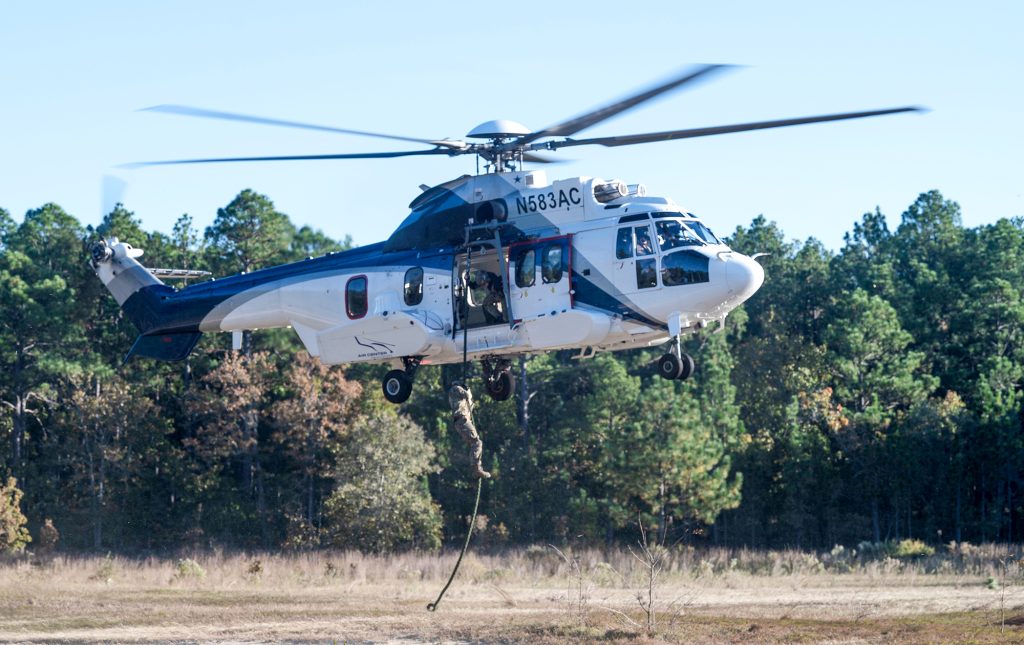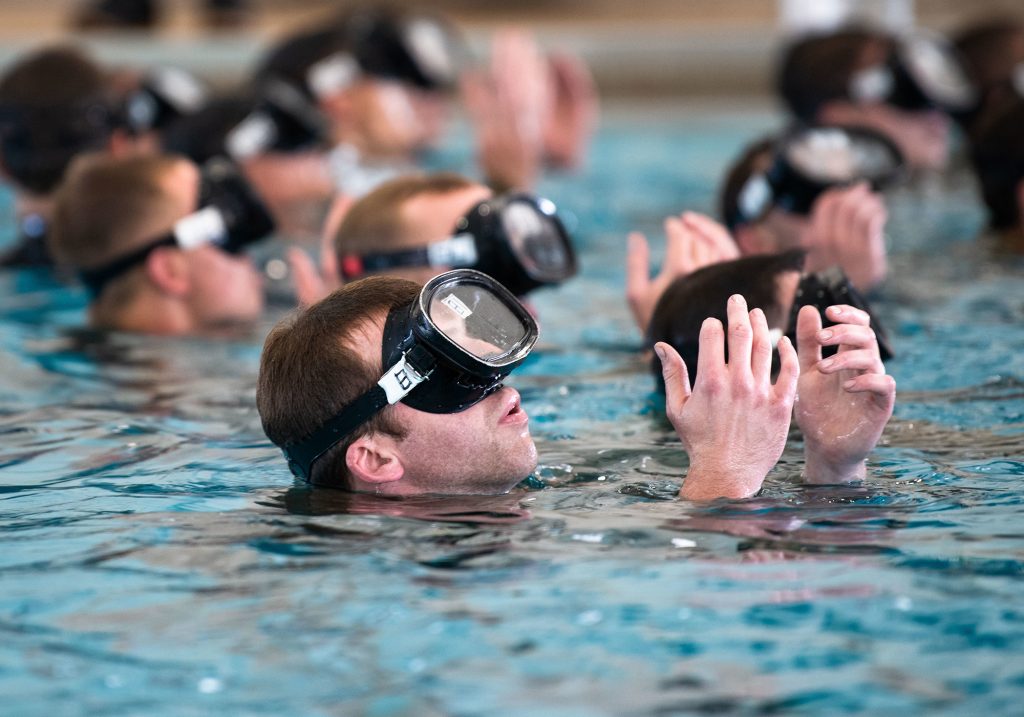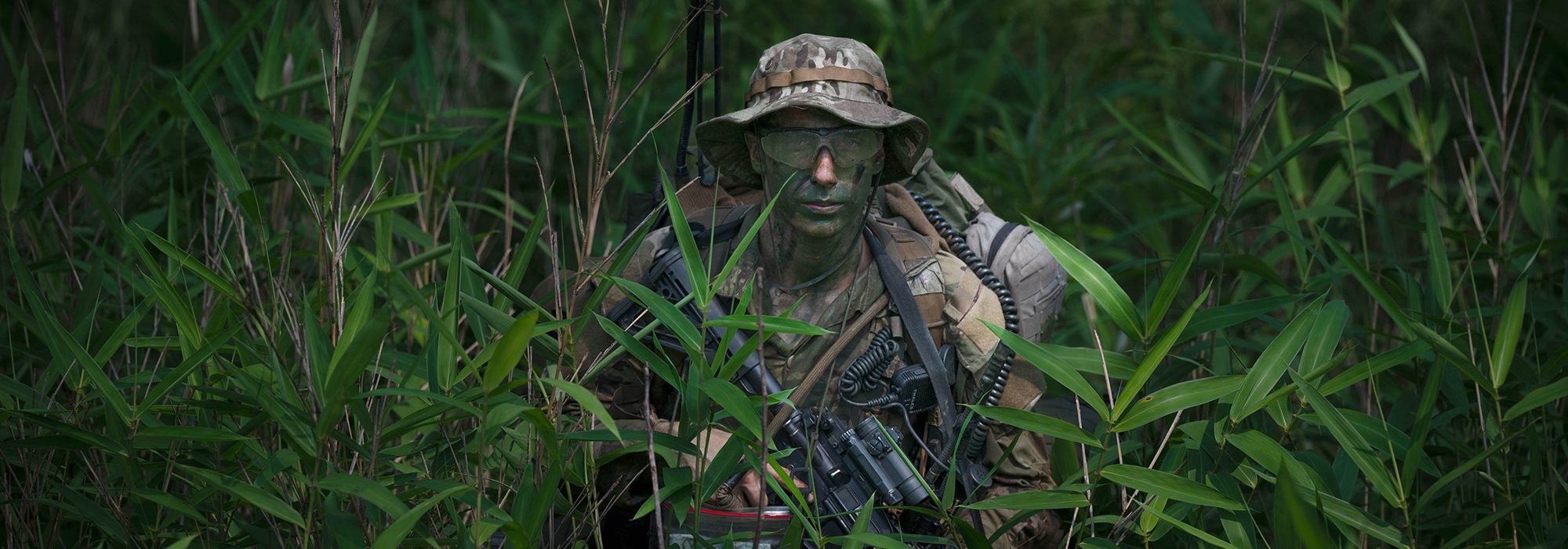Fort Liberty N.C.
In most professions, the path of least resistance is the best. Not so for the Air Force’s newest special warfare field: special reconnaissance (SR).
“Going through sniper school, you try to walk through the worst terrain that you can find because that’s where nobody else wants to go,” said “Tech Sgt. J,” a senior Airman whose full name was withheld for security reasons. “Vines and sticks grabbing onto your ghillie suit [camouflage] … it can be a pretty humbling experience.”
Sneaking through swamps is another. The goal is to provide timely and accurate intelligence to enhance the effectiveness of airpower from the ground. These Airmen must master the full range of reconnaissance skills, from silently inching their way through brush in a ghillie suit to zeroing in on a target through a sniper scope to flying small drones or employing technical equipment to achieve cyber or spectrum effects.
“All the other sister services have their own reconnaissance assets,” J said. “The Air Force was looking at a more niche capability, specifically for what kind of problems pilots are going to have.”
Special Tactics Officer, Capt. Max Krasnov, 352nd Special Warfare Training SquadronIt sounds silly, but it is a skill just knowing how to walk through the woods in a tactical manner.
SR evolved in 2019 to replace special operations weather teams (SOWT), whose mission had been to gather weather and environmental intelligence in hostile territory. In the years before that shift, SOWT Airmen started adopting some of the skills that make up the core of SR today. Though SR training still includes some weather elements, the main purpose now is to provide air-minded reconnaissance to open up routes for aerial attack against sophisticated air defenses.
“Basically we are looking at solving the integrated air defense problem that China, Russia, or Iran is going to have,” J said. “We’d be looking at opening airways for follow-on forces. The Air Force doesn’t want to have to rely on Army assets to open up those airways.”
In a future conflict, SR Airmen will be tasked with observing enemy anti-air defenses, gathering intelligence on enemy troop movements, conducting real-time battle damage assessments after airstrikes, and scouting landing zones. Satellites or aerial reconnaissance may be unavailable at times, making old-school intel a crucial alternative.
“We weren’t doing that in Afghanistan because there was no reason to accept that risk—we could just put an MQ-9 over the target for a week,” said Capt. Max Krasnov, a special tactics officer and training flight commander with the 352nd Special Warfare Training Squadron at Pope Army Airfield, N.C. That’s not possible against better-equipped nation-states. So SR “ensures that the Air Force has a way to get the ground truth under any situation,” Krasnov said. “That’s why they are trained to the full gamut of reconnaissance techniques that are currently available.”
In terms of cyber and electronic warfare, Tech. Sgt. J said SR provides “the link between the big computers and the target,” but stopped short of detailing specific capabilities for security reasons. But Krasnov hinted at what that might look like with an example: “If I were to walk into a hotel lobby, log onto the guest Wi-Fi on my cellphone, and get the IP address that my phone connected to, I am gathering information about that hotel,” he said. “Play with your imagination as to where that can go.”
The wide range of skill sets involved in SR means there are plenty of rabbit holes for Airmen to dive down.
“What I think is a cool thing about the career field is there are certain vectors that guys can really nerd out about,” J said. “Maybe a dude just really wants to deep dive into drones, you can do that. Guys want to go cyber warfare or higher-level intelligence gathering, we have avenues for that.”
The Air Force counts just 50 SR Airmen in its ranks today, with hopes to double that in the coming years. Among them could be Airman 1st Class S, a trainee in the SR Apprentice Course at Pope, who was attracted by the newness of the field.
“It was new and there are only a few people doing it … so I was curious to see what it was like,” he said.
SR is also attracting former special forces troops from other services, among them at least three prior Marines and a prior Green Beret Soldier.
“There has actually been, in my opinion, a surprising amount of cross-trainees or prior service people coming through,” said Tech. Sgt. J, who listed long-range-shooting and cyber warfare as two reasons why some of them sought out SR.
Being so new, SR Airmen often have to explain what they do when they arrive downrange, but J considers that a strength rather than a weakness.

“I honestly think that it is a benefit for the kind of people we attract, because then they are forced to go out and prove themselves and their capabilities,” said the former SOWT
J was attached to a team of Green Berets in Afghanistan a few years ago. “I showed up and I said, ‘Hey, this is my little drone, this is what I can provide for you guys. I’ve got this training up into this shooting school, I’m a jumpmaster, I can do all this,’” he said. “And then the next step is to go to the range of that team and outshoot them.”
Special Reconnaissance Commandos
Two Airmen hid in the dark, in a small hole by the side of the road running through a pine forest. Across the road, just 80 yards away, was their target: a train station they had to monitor for 24 hours for signs of enemy movement. It was bold to creep up so close, but the small ridge line into which they had dug their hide site blocked the sight lines from deeper in the woods.
The Airmen were eventually caught by the “enemy” in this training exercise, but the inconvenient ridge helped illustrate why SR Airmen are needed.
“Even if you have satellite imagery, you’re not going to pick up this little hill that makes a very big difference,” said Krasnov, the special tactics officer. “If you’re back 200 yards, you can see cars drive by, but that’s about the level of fidelity you can get. … If we need them to positively identify a guy with a mustache and a limp in his left leg, that is going to drive how bold they are about where they need to be.”
Sneaking up on a target requires its own set of skills, especially in this part of North Carolina, where the ground cover is sparse and a carpet of pine needles crunches underfoot.
“It sounds silly, but it is a skill just knowing how to walk through the woods in a tactical manner,” Krasnov said. “If you go hunting and sit in a tree for hours, and all of a sudden a deer appears, you’re like, ‘How did that just get there? I didn’t hear it, I didn’t see it walking up.’ Someone who’s really good, it’s almost like they can do that.”
Crawl, Walk, Run
By the time Airmen arrive at Pope for the SR and Combat Control Apprentice courses, they already have been training to join special tactics for months. The pipeline starts with the Special Warfare Candidate Course, followed by the grueling Special Warfare Assessment and Selection Course, both at Joint Base San Antonio-Lackland, Tex. Part of the goal of those courses is to put candidates through intense physical training to see if they can handle the demands of the profession.
Those who pass through assessment and selection go on to a series of schools across the country such as pre-dive swimming and water confidence, static line parachuting, freefall parachuting, and survival, evasion, resistance, and escape (SERE) training. The journey continues at the four-month apprentice course.
“The diving and jumping, that gets you to work,” Krasnov said. “This course is what you do when you get there.”
Crawl, walk, run is the name of the game. Students learn how to read a map and compass, then start navigating through the woods, a change of pace for many who have relied on GPS-enabled smartphones all their lives. They learn how to safely handle a firearm and how to shoot accurately, how to move on a battlefield, and how to position themselves in a team fight. Later, they master small-unit tactics, like bounding movements and ambush maneuvers.
After-action reviews are intense. “If you’re doing an L [-shaped ambush], you’ve got to make it an L, it can’t be, I don’t know, whatever the [blank] that was,” one instructor said, bluntly criticizing his charges after a drill. “While you’re making these big flanking movements, you’ve got to make sure you’re keeping track of where you are geographically in relation to your support-by-fire, so they can effectively support you.”
Easier said than done. Students had to yell commands through gas masks as fake artillery rounds went off around them and smoke grenades tinted the air pink and purple. An untrained observer could barely identify the camo-clad students amid the leaves. But learning how to operate in such confusing and stressful conditions is among the objectives of this course.
“Anyone can learn to program a radio—it’s not hard,” said Krasnov. “We need people who can reprogram a radio when they are cold, hungry, haven’t slept in two or three days, and are in the middle of a firefight.”
Bread-and-Butter
Usually about a quarter of the students at Pope aim to join SR, while the rest hope to become combat controllers (CCTs), who are experts at coordinating aircraft with ground operations. The students train on many skills together, such as land navigation and small-unit tactics, but they split up for skills specific to each career field. The SR Airmen learn the basics of weather observation, intelligence processing and reporting, surveillance and reconnaissance equipment and techniques, long-range shooting with the M110 rifle, and stalking lanes, where Airmen build ghillie suits, using grass or other forms of ground cover camouflage, and learn to move around undetected.
“It looks super cool,” said Tech. Sgt. J, a SR instructor. “And then you do it for the first time and you realize that it is miserable, especially if it’s really hot out. People don’t realize how hot ghillie suits are.”
In the stalking lanes, J explained, students have to sneak up to a truck full of instructors, close enough so they can identify the letter on a placard one of them is holding up—all while evading the trained eyes of the instructors. It is a difficult task, but an essential step in training to sneak deep into enemy territory.
“Even if SR Airmen use cyber or electronic warfare, they still have to get to a location the enemy doesn’t want them to be, without them knowing,” Krasnov pointed out.
The SR students learn the basics of operating small unmanned aerial systems, starting with quadcopters about the size of a dinner plate. Though easy to fly, operating them effectively in an undercover military operation requires deep understanding, such as how high to fly to remain undetected, counter-drone techniques adversaries might use to evade drones’ thermal sensors, safe operating ranges and timelines, and how many spare batteries to bring for a mission.
Still, the apprentice course is only a starting point. Graduates continue honing their skills for six more months at a special tactics training squadron when they’re finished. Advanced SR skills include operating fixed-wing drones and top-secret cyber and electronic warfare tools.
Best Friends
The apprentice course ends with a weeklong final training exercise where CCT and SR students demonstrate the skills they learned over the past four months. The exercise often begins with students parachuting into a simulated contested environment, after which they must establish a forward operating base and pursue follow-on missions, like striking a target or capturing an airfield to land a C-130 or to airdrop troops and supplies.
The exercise gives the students a chance to practice the basics of their respective career fields: CCT students may establish and operate an airfield or call in air support, while SR students may have to sneak up on a target and gather intelligence for an ambush. The exercise ends with a 15-mile ruck march back to base.
Graduation is a hard-won moment for both students and instructors. “These students, within a year they’re going to be on teams with all of the instructors’ best friends,” Krasnov said. Instructors are incentivized to do a good job. “One, the instructors want to make sure they’re not going to get their friends killed. And two, all their friends know that we are responsible for the quality of the students. So they don’t want their buddies to rag on them for producing bad students.”
What’s Next For Air Force Special Tactics?
SR Airmen are trained to infiltrate deep into enemy territory to gather information on enemy air defenses. That mission is part of a larger shift as the military prepares for conflicts with near-peer adversaries such as China and Russia.
Older special tactics career fields are also feeling the shift as they focus on skills not often utilized during the past 20 years of the Global War on Terror (GWOT). For example, CCTs are certified Federal Aviation Administration air traffic controllers who can establish airfields in hostile environments. But during the GWOT, they often served as joint terminal attack controllers, calling in airstrikes to support ground troops.
“For us, GWOT was the JTAC mission,” said Krasnov. “We were doing some airfield missions, but I would say 95 percent of what we were doing was JTAC.”
As the Air Force prepares to operate from small islands in the Pacific, CCTs may find themselves helping guide aircraft to austere airfields more often than they did in GWOT.
“Historically, the air mobility mission is one of our bread-and-butters,” he said.
In May, CCTs with the Kentucky Air National Guard’s 123rd Special Tactics Squadron guided MC-130J transport aircraft, A-10 attack jets, MH-6M helicopters, and MQ-9 drones in for a landing on two highways in Wyoming, an exercise meant to practice generating airpower in austere locations. A new CCT recruiting ad also emphasized that role with the line “we turn hell into an airstrip … and clear the way for others to follow.”
Meanwhile, the JTAC mission could take a different form in a near-peer conflict, where enemy air defenses may force friendly aircraft to use longer-range munitions dropped farther from the target. In that situation, SR Airmen, who specialize in deep reconnaissance, may serve as remote spotting scopes for CCTs farther away.
“There are a lot of scenarios where the JTAC is back at the base and a team is passing the relevant information of what’s going on,” Krasnov said. “They know the ground truth, but I am trained to process that and explain it to aircraft.”
Pararescue
In the GWOT, pararescue jumpers [PJs] often rode helicopters out to injured troops and cared for them on the flight back to a large base with robust medical facilities. But in a near-peer conflict, operators may be much farther from medical facilities, and there may be no flights due to distance and enemy air defenses.
“There was no chance a mission was getting approved if there was not a specific plan that anyone on that mission could get transported to a high level of surgical care within an hour,” Krasnov recalled about his GWOT deployments. “To go from that to ‘we’re probably not going to hear from you for a week’ is a much different mindset and a much different level of risk that you need to plan for.”

PJs are now training to provide care for more patients for longer periods than they typically did during the GWOT. In a recent exercise off the coast of California, PJs practiced caring for injured patients amid missile strikes, contested airspace, limited supplies, and other challenges meant to simulate what they may face in a war in the Pacific. In one scenario, Airmen treated about two dozen patients after a missile strike on an airfield, then moved them to a contingency location via helicopter.
“This simulates one of the most likely mission sets we could respond to: mass casualties caused by a missile strike at a forward operating site,” Master Sgt. Trevor Runyan, the instructor flight chief at the 68th Rescue Squadron, a formal training unit for PJs, previously told Air & Space Forces Magazine.
Later on, the PJs rescued simulated pilots who had been shot down and landed in the water. Some had drifted into contested airspace, so the PJs jumped out of fixed-wing aircraft with parachute-configured Zodiac boats to pick them up, then bring them back to friendly airspace where a helicopter could carry them to shore. Throughout the exercise, the PJs juggled multiple missions and limited resources.
“As a 10-man element, they must prioritize missions and determine if and when they should operate as a split team, and the risks associated with that,” Runyan said.
While counterterrorism missions continue in the Middle East and Africa, special operations forces across the military are reassessing their approach to risk in preparation for near-peer conflict.
“For U.S. ground special operations leaders, attitudes toward risk tolerance remain shaped by the last two decades of war in the Middle East and Africa,” special operations expert Spencer Reed wrote in January for War on the Rocks. “But if these leaders are to offer utility to the joint force or their parent services in the future fight, they should reframe and reassess how they view risk now, ahead of a future armed conflict with a great power adversary.”
